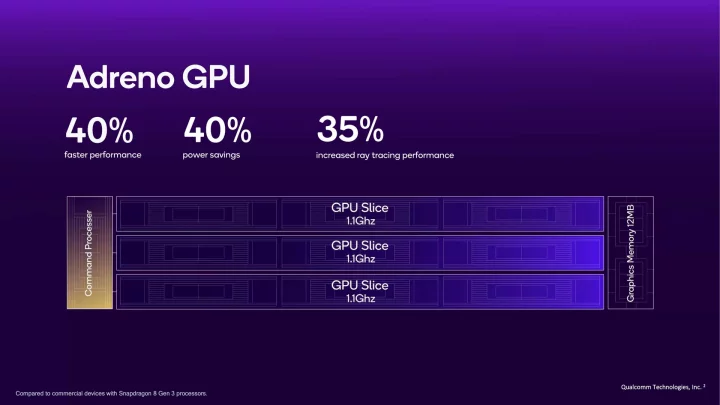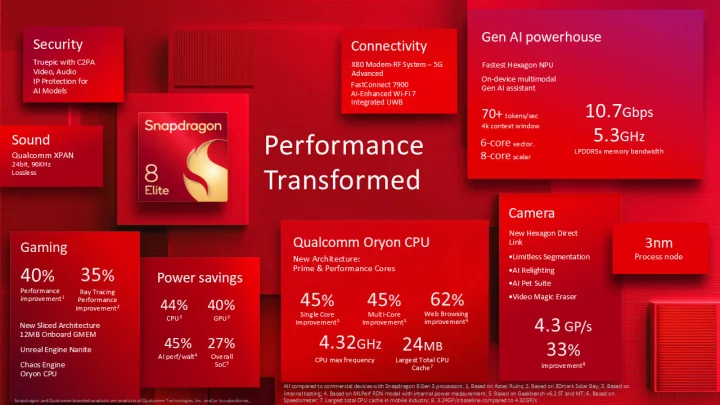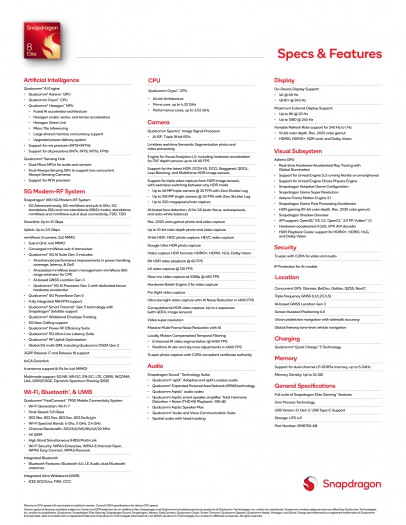The time of new generations of mobile phones is coming, and with them also the new Qualcomm processor, which is the king of Android smartphones, at least in the more expensive category. The company has now introduced its new generation of mobile SoC, which is called Snapdragon 8 Elite. As the Elite might already suggest, this is a remarkable innovation, as Qualcomm is bringing its own powerful Oryon architecture from notebook processors released this summer to mobile phones in these chips.
The Snapdragon 8 Elite is the successor to last year’s Snapdragon 8 Gen 3 (the new generation was referred to as “8 Gen 4” until now) and is also the first Snapdragon to be manufactured using the 3nm manufacturing process, using TSMC’s N3E technology. As usual, the chip has a whole range of changes and innovations, but the main topic will undoubtedly be the CPU.
Return to own architecture
Qualcomm originally used its own cores (Scorpion, then Krait) in Snapdragon mobile processors, but this was still in the 32-bit ARM era. With the advent of 64-bit cores, Qualcomm basically switched to ARM-licensed cores and discontinued its own development (so it’s true that Qualcomm tried to use them in servers, but that also ended quickly). At that time Cortexes (especially at the time of the A75 and A76 cores) had a very good period, so Qualcomm gave up on its own 64-bit Kryo core and it paid off (competitor Samsung with its own cores also had to capitulate). But then again, with Cortex cores, ARM lagged behind the even more aggressive ARM, and the need for its own CPU core returned.
Qualcomm managed to solve this by buying Nuvia, which gave it access to Apple’s engineering team and their Oryon core, from which big things were expected. And basically, the promise was fulfilled, because it is a core that is still competitive with the best from AMD and Intel (even with Apple) – Qualcomm has already introduced Oryon in notebooks in Snapdragon X Elite and Plus processors, so it knows what it can do.
Ironically, ARM caught on around the same time, and its Cortex-X925 (“Blackhawk”) should also have the most competitive single-threaded performance against said competition in a long time. This means that the Snapdragon 8 Elite will probably be a significant leap forward, but only the tests will show if it is also a leap ahead of the competition, such as the recently revealed MediaTek Dimensity 9400 with Cortex-X925.
Oryon second generation, no small cores?
The Snapdragon 8 Elite has eight cores that follow the big.LITTLE principle, but they no longer seem to use ARM’s small or even mid-range cores – neither the Cortex-A520 nor the A725. Instead, the SoC appears to have cores themselves with their own architecture. In the role of large cores is Oryon with 192kB L1 cache and a clock speed of up to 4.32 GHz, there are two of these cores. The other six cores should also be Oryon derivatives, but in some trimmed down version quite possibly with lower IPC – we know for example that they only have 128kB L1 cache. The frequency of these smaller cores is a maximum of 3.53 GHz. Both the large-core cluster and the more economical six-core group have their own shared cache block, both with a capacity of 12 MB.
According to Qualcomm, the architecture used is already the second generation of Oryon, but it is questionable whether this means any big changes, especially when the chip comes out so soon after the notebook’s first generation. Perhaps that second generation mainly arises from the transition to a new production process, and this core is therefore just a “tick” in the older terminology used by Intel, not “tock” meaning a truly new architecture. You can read our detailed breakdown of what the first generation Oryon core looks like inside:
The fact that the clock speed of the Oryon cores is as high as in the notebook variant (4.32 GHz is a record for phones) promises very good single-threaded performance. At least top-notch – only tests will show what will be sustainable under longer loads. According to Qualcomm, the CPU should achieve up to 45% better single-threaded and multi-threaded performance compared to the previous generation (measured in Geekbench 6.2 ST and MT) and/or up to 44% better energy efficiency. The Snapdragon 8 Elite is said to be the fastest mobile processor in the Geekbench 6.2 single-threaded benchmark (not 6.3, where Apple might have an advantage thanks to SME2), AnTuTu, Speedometer, SPECINT, and in Geekbench 6.3 when it comes to the multi-threaded test. This is supposed to be true at its peak performance of 4.32 GHz.
Older instruction set
Perhaps it is good to mention one thing. While ARM itself is promoting the transition of processors to the newer version of the ARMv9 instruction set (now already in the ARMv9.2 version), the Oryon cores are “frozen” on the older, albeit still 64-bit, version of the ARMv8 architecture.
It probably has licensing reasons as well, since ARM is in a dispute with Qualcomm, probably mainly in an attempt to force higher license fees. Apple’s processors also remain on the ARMv8 architecture, although in the last generation they received new special SME2/SSVE accelerators. However, Apple left out the general SVE/SVE2 SIMD extension, so it is possible that the company will only choose what it likes, and it does not yet plan full compatibility with ARMv9.
New Adreno
In addition to the processor part, other parts are naturally also upgraded. The new Adreno graphics are supposed to have up to 40% better performance and 40% better energy efficiency (which would imply that the performance increase is at the same consumption) against the previous generation (Adreno 750). Performance in ray tracing, whose hardware acceleration is again supported, is supposed to be 35% better.
The new architecture uses three “slices” and a frequency of 1.1 GHz. The transition from a monolithic GPU to a multi-slice concept is advantageous in that individual slices can be put to sleep when maximum performance is not needed, and the simplification has reportedly also enabled better clocks. The newly added command processor divides the work among the individual slices (which also controls their clocks and puts them to sleep as needed). The GPU should have its own 12MB cache, which is designated as graphics memory.
The graphics still don’t support full OpenGL, but can handle OpenGL ES 3.2, OpenCL 3.0 FP, and Vulkan 1.3. For games, it provides Snapdragon Super Resolution upscaling, perhaps even with frame generation (Qualcomm mentions the presence of Adreno Frame Motion Engine 2.1). At the launch, the manufacturer boasted, for example, support for Unreal Engine 5.3 with Nanite geometric technology, which was put into operation on mobile phones with Snapdragon in cooperation with Epic.
The graphics can drive up to a 4K display (at 60 Hz) or 2560 x 1440 pixels at 240 Hz. An external screen can have a resolution of up to 8K at 30 Hz, but a 240 Hz frequency can only be used externally on a Full HD monitor. Among the multimedia functions, video support in H.265, VP9 and AV1 formats is mentioned, but not yet H.266 (VVC). The Snapdragon 8 Elite can compress to HEVC.
The graphics (but also the CPU) will supply the necessary data throughput LPDDR5X memory, which can have a capacity of up to 24 GB and an effective speed of 10,667 MHz (LPDDR5X-10667), i.e. the same as that used by the Dimensity 9400.
NPU and continuous voice and video monitoring from cameras
Naturally, the SoC also has an NPU unit labeled Hexagon, which contains scalar, vector and matrix accelerators and can perform calculations with INT4, INT8, INT16 and FP16 precision, or combined precision (INT8/INT16). Some theoretical performances in TOPS are not mentioned, but the performance of the NPU is said to be 45% better against that of the Snapdragon 8 Gen 3, and the performance per unit of consumption is also supposed to be 45% better. Another novelty is that the NPU, like the image processing unit (ISP) of the Spectra, has its own direct connection to the sensors to directly receive raw data (Hexagon Direct Link) without going through the ISP.
In addition to the NPU, the chip also has a Sensing Hub, which has its own image and voice processing functions, enabling continuous analysis of input for, for example, a voice assistant. However, this Sensing Hub is apparently able to continuously process (using AI) data from up to two image sensors. For this, it uses two integrated micro NPUs with their own DSP and dedicated memory.
Up to 10Gb/s modem
The SoC has its own integrated modem with 5G Advanced support, which is in generation Snapdragon X80 (whereas the previous generation had a Snapdragon X75 modem). This modem contains its own small NPU or AI accelerator, which it can use to optimize the connection. Download speed can theoretically be up to 10 Gb/s and uplink up to 3.5 Gb/s. Six-fold carrier aggregation (6CA) with six antennas is needed to achieve this theoretical speed. This aggregation is supported in both Sub-6 and mmWave spectrum.
Wi-Fi and Bluetooth, on the other hand, are handled by an additional chip, the Qualcomm FastConnect 7900 chip is to be paired with the processor, which supports Wi-Fi 7, Ultra Wideband (UWB) and Bluetooth 6.0. This chip is also said to have its own small AI processor to improve its operation and also uses a 6nm manufacturing process against earlier Wi-Fi chips which were still 14nm. This should improve consumption and efficiency.
For high-end phones
Due to its advanced features and 3nm manufacturing process, the chip will probably be quite expensive (it is believed to be the most expensive of the mobile SoCs offered by Qualcomm so far), and therefore it will probably only appear in “flagship” and similar expensive smartphones (whose prices may also rise). Samsung, Asus, Xiaomi, Realme, Vivo, Oppo, OnePlus, iQOO, Honor “and others” are preparing phones with it.
According to Qualcomm, some of these phones will be released in the “coming weeks”, so the availability of devices with the Snapdragon 8 Elite could hopefully be before the end of the year.
Sources: Qualcomm (1, 2), ComputerBase
Source: www.cnews.cz





